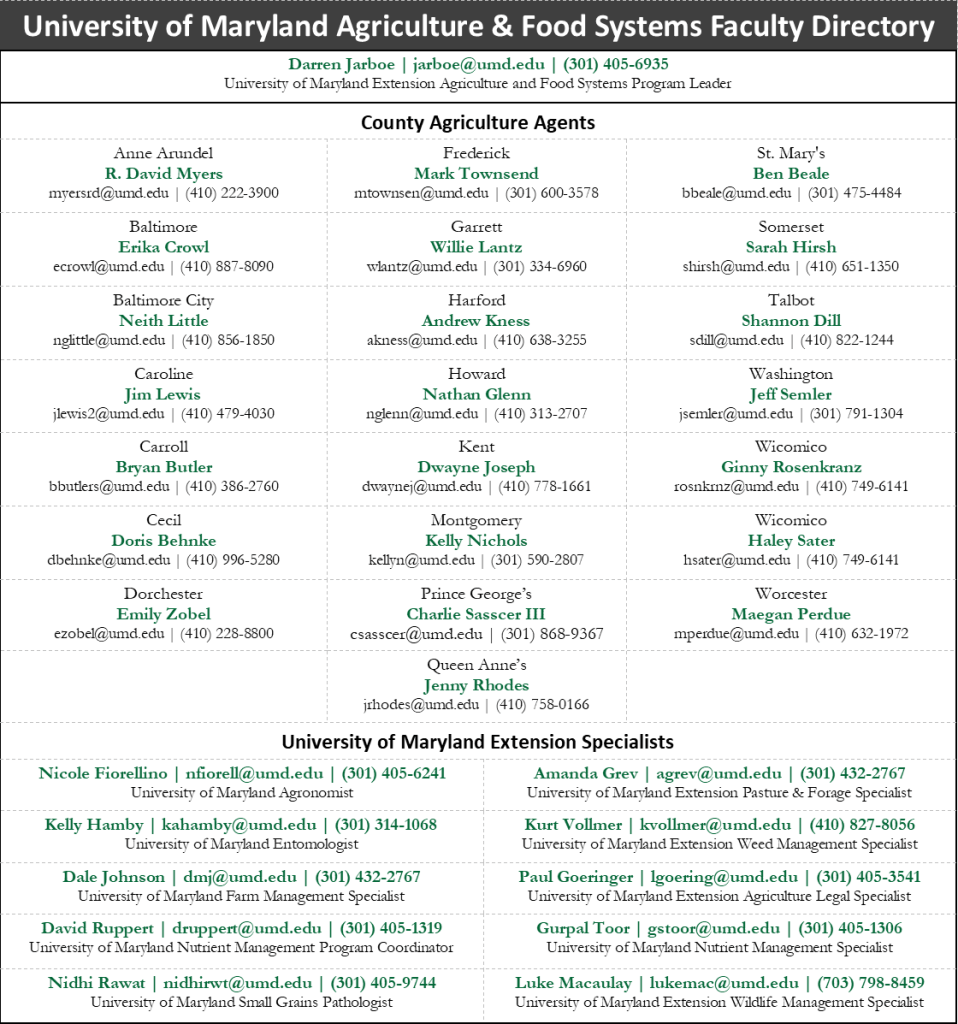Reports are for crop conditions up to June 1, 2023.
Western Maryland
To say we are dry would be an understatement. Corn planting is winding down and the last of the full-season beans will soon be finished up too. Barley and wheat are in full head a bit ahead of normal, whatever that is. The dry weather is a good thing for cereals as the conditions are poor for fungal growth. It will be interesting to see what effect the dry weather will have on test weight and yield. First cutting alfalfa and most of the grass hay is in the barn or silo. Rain will be important very soon for forage regrowth and corn and bean growth. The cool evenings and overnights have been the only blessing but heat is on the way.—Jeff Semler, Washington Co.
Central Maryland
Frederick County has finished planting corn. There may be the occasional field that remains, but this is the exception. Early corn is at the V4-5 stage while later planted fields are approaching V2. Seedling diseases have been nearly non-existent in scouted fields, though wireworm pressure has been observed in both corn and soybean fields. Soybeans are 90% planted; early beans are around V2 while most are VC-V1. The majority of the hay crop is made and in the barn. Annual weeds have emerged and are approaching a foot tall in some fields, though weed pressure has remained limited given the dry weather and resulting effective burndown applications. Second cutting alfalfa is underway, some weevil pressure had been observed in the occasional field though generally there has been relatively limited pressure. Most barley is at or near soft-dough stage, while the wheat crop has finished flowering and is moving into grain fill. Both small grain crops appear in good to great condition given the limited disease pressure.—Mark Townsend, Frederick Co.
Northern Maryland
We got through the entire month of May without any measurable precipitation. Such weather has made for great conditions for making hay, and this is one of the few times in recent memory where pretty much all of the first cutting hay crop was put up before June 1; although yields did appear to suffer in some fields due to the dry weather. 99% of the corn crop is planted and emerged, with earliest planted corn around V5-6. Almost all full-season soybeans have been planted and are anywhere from just planted to V3-4. Both corn and soybeans have yet to show wilting, but they are both growing very slowly due to the lack of rain. Fortunately we are running well below with temperatures in the 70s most of the month. Wheat is just starting to turn and appears to have very little disease pressure; we will see how the dry spring affects yield and test weight. We are hoping for a bit of rain in the coming weeks.—Andy Kness, Harford Co.
Upper and Mid Shore
Early planted corn greened up, but definitely has reduced yield potential. Later planted corn looks great- good color and uniform. Early beans are finally outgrowing slug feeding. Like corn, later beans look great. Barley harvest will begin 1st week of June. Wheat is starting to turn. There was great hay made last week. Soil conditions across the region are getting dry.—Jim Lewis, Caroline Co.
Lower Shore
Wheat and barley are drying down. Corn has been planted, and is generally around V1 to V5 stage. Most soybean has been planted and early soybean plantings have emerged. Herbicide-resistant weeds, such as common ragweed, marestail, and palmer amaranth, are starting to emerge. Scout and spray early to stay ahead on control. Some farmers have utilized late-terminated cover crops to help manage weed pressure through providing a mulch on the soil surface. Deer are prevalent in fields and causing damage on corn and soybean seedlings.—Sarah Hirsh, Somerset Co.
Southern Maryland
Temperatures finally touched the 80°F mark this week. Cooler temperatures and lack of rainfall has slowed crop progress in May. Most corn fields are a kaleidoscope of yellow shades and uneven stands. Black cutworms, slugs, wireworms and seed corn maggot are active across the region. We received scattered showers last weekend that helped crop conditions improve in most areas. Soybeans follow much of the same story. Early planted beans look decent. Barley is drying down with harvest expected any day. Wheat will not be far behind. Ryegrass continues to be a challenge for producers in both burndown situations in corn and beans, as well as small grains. My thought is the cooler weather is affecting the performance of glyphosate, especially on larger plants. The pockets of glyphosate resistant ryegrass are expanding in our area as well. The drier weather has been good for making hay- we saw a lot of balers in the field last week.—Ben Beale, St. Mary’s Co.
*Regions (counties):
Western: Garrett, Allegany, Washington. Central: Frederick, Montgomery, Howard. Northern: Harford, Baltimore, Carroll. Upper & Mid Shore: Cecil, Kent, Caroline, Queen Anne, Talbot. Lower Shore: Dorchester, Somerset, Wicomico. Southern: St. Mary’s, Anne Arundel, Charles, Calvert, Prince George’s


